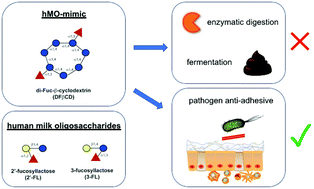Digestion, fermentation, and pathogen anti-adhesive properties of the hMO-mimic di-fucosyl-β-cyclodextrin†
Abstract
Human milk is widely acknowledged as the best food for infants, and that is not just because of nutritional features. Human milk also contains a plethora of bioactive molecules, including a large set of human milk oligosaccharides (hMOs). Especially fucosylated hMOs have received attention for their anti-adhesive effects on pathogens, preventing attachment to the intestine and infection. Because hMOs are generally challenging to produce in sufficient quantities to study and ultimately apply in (medical) infant formula, novel compounds that are inspired by hMO structures (so-called “mimics”) are interesting compounds to produce and evaluate for their biological effects. Here we present our thorough study into the digestion, fermentation and anti-adhesive capacity of the novel compound di-fucosyl-β-cyclodextrin (DFβCD), which was inspired by the molecular structures of hMOs. We establish that DFβCD is not digested by α-amylase and also resistant to fermentation by microbial enzymes from a 9 month-old infant inoculum. In addition, we reveal that DFβCD blocks adhesion of enterotoxigenic E. coli (ETEC) to Caco-2 cells, especially when DFβCD is pre-incubated with ETEC prior to addition to the Caco-2 cells. This suggests that DFβCD functions through a decoy effect. We expect that our results inspire the generation and biological evaluation of other fucosylated hMOs and mimics, to obtain a comprehensive overview of the anti-adhesive power of fucosylated glycans.



 Please wait while we load your content...
Please wait while we load your content...